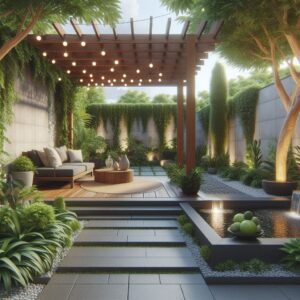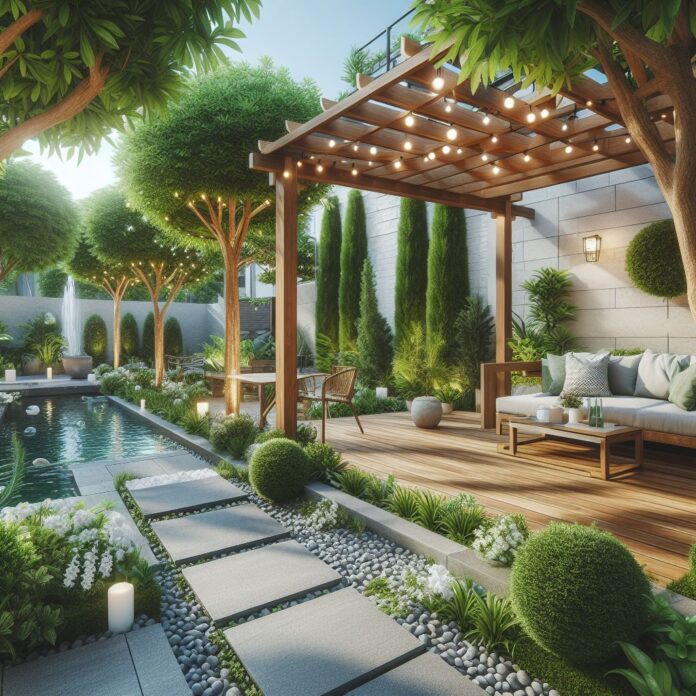Envision stepping out of your door into a world of chromatic bliss. Imagine a kaleidoscope of hues greeting you at every turn, creating a tranquil oasis right in your backyard. This vivid imagery isn’t just an artist’s fantasy—it’s the wonderful reality of strategic garden colour design. For garden enthusiasts, landscapers, and designers alike, grasping the art of using nature’s palette is fundamental to crafting landscapes that are not just visually pleasing, but also evoke emotions, and support ecological harmony.
In this extensive guide on garden colour theory, we will explore the principles of colour in garden design, the psychological effects of colour, and practical tips for using color effectively in your outdoor spaces. By the end, you’ll be well-equipped to transform any patch of earth into a brilliant canvas of life.
The Garden designs
Understanding the principles of colour is the first step in mastering the art of garden colours. Colour not only shapes how we perceive space but also influences our emotions and interactions with the garden environment. The color wheel, a fundamental tool in garden design, categorizes colors into primary (red, yellow, blue), secondary (a combination of primary colors), and tertiary (a mix of primary and secondary colors). This framework helps gardeners to create harmonious or contrasting color schemes that can enhance or transform outdoor spaces. Additionally, the use of color can influence the perceived temperature of an area, with warm colors (reds, oranges, and yellows) creating a feeling of warmth and cool colors (blues, greens, and purples) evoking a sense of calm. By applying these principles, designers can create gardens that are not only a feast for the eyes but also cater to the wellbeing of their inhabitants.

Understanding Garden Colour Theory
1. The Basics of Colour
Before we can become artists of the garden, we must understand the basic terms of colour. Colour is a product of light, and it is perceived by the human eye thanks to special cells called cones, allowing us to differentiate and enjoy the wide spectrum of colours.
- Hue: The pure state of a colour, as it appears in the spectrum (green, blue, red, etc.).
- Value: The lightness or darkness of a colour, often referred to as tint (lighter) or shade (darker).
- Saturation: The intensity of a colour.
2. The Colour Wheel
The colour wheel is a visual representation of how colours relate to one another. It is divided into three categories:
- Primary Colours: Red, blue, and yellow, which are the foundation for all other colours.
- Secondary Colours: Purple, orange, green, which are created by mixing the primary colours.
- Tertiary Colours: These are the six shades between primary and secondary colours.
Understanding the color wheel is pivotal as it provides a guide for harmonious color combinations.
3. The Psychology of Colors in Gardens
Emotional Responses to Color
Different colors can evoke a myriad of emotional responses. For example:
- Red: A color of passion and energy, red demands attention and can create a sense of warmth.
- Blue: Often associated with serenity, blue can create a calming effect.
- Yellow: The color of sunshine, yellow is joyful and can bring a sense of cheerfulness to a space.
4. Color Schemes and Combinations
Color schemes are arrangements of colors that are considered pleasing. There are several popular schemes:
- Monochromatic: Using various shades and tints of a single color.
- Analogous: Using colors that are adjacent on the color wheel, like blue and green or red and orange.
- Complementary: Colors that are opposite on the color wheel, which, when used together, create high contrast and vibrancy.
5. Garden Type and Plant Selection
The first step in applying color knowledge to your garden is to select the appropriate plants. Consider:
- Perennials: Plants that will return year after year, providing consistency in color.
- Annuals: These offer rapid, vibrant color but are more temporary.
- Shrubs and Trees: Their size and color need to balance and complement other elements of the garden.
Harmony and Balance
Harmony can be achieved through using shades and tints of the same color, while balance can come from the strategic use of color in different areas of the garden. This will help prevent the eye from being overwhelmed and will create a cohesive whole.
Focal Points and Hardscapes
Incorporating focal points and hardscapes brings variety to the composition of the garden. Consider the color of these structures and ensure they add to the overall color story without distracting from the natural elements.
Time and Season
Color in the garden is often associated with particular times of year. Be mindful of the seasonal changes in color and plan your garden to have year-round interest.
Practical Tips for Colourful Garden Design
Keeping it Real with Nature
While it can be tempting to create a ‘rainbow’ garden, remember that nature has its own perfect color combinations. Observe and draw inspiration from the natural landscapes you love.
Textures and Foliage
The texture and shape of plant leaves can be as important as their color. For example, the sharp geometry of succulents pairs wonderfully with softer, flowing grasses, creating a striking contrast.
Environmental Considerations
Your region’s climate and soil play a significant role in the success of your garden. Choose plants that not only offer the right colors but are also suited to the conditions of your site.
Testing Combinations
Before making large-scale changes, experiment with colors. Consider dabbling with an online garden planner or simply use digital images of your garden and overlay color choices before committing to the plantings.
Case Studies of Successful Garden Color Palettes
The Cottage Garden
Cottage gardens often employ a riotous mix of colors, yet still appear harmonious. This is achieved through careful balance and a variety of plants that bloom at different times, ensuring a constantly changing color scheme.
The Modern Garden
Modern gardens often feature a more restrained color palette. They might, for example, play with various shades and tints of the same color to create a peaceful, unified space.
The Edible Garden
Edible gardens can also be beautiful! By choosing colorful fruits and vegetables, you can incorporate unexpected, functional bursts of color into your space.
Enhancing Your Garden with Color
Utilizing Structures and Pathways
Painted fences, trellises, and winding pathways can not only add a decorative element but also serve as a canvas for the color in your garden.
Art in the Garden
Including art in your garden is a creative way to infuse colour. You might place colorful sculptures or hang paintings on garden walls to add whimsy and vibrancy.
Maintaining and Adjusting Colour Schemes Over Time
Seasonal Adjustments
Seasonal plants can offer a simple way to change the color scheme. Replace summer annuals with fall bloomers to reflect the seasonal change in your garden.
Regular Evaluation
Make it a habit to assess your garden’s colour scheme. Is there too much of one hue? Are there areas where color could be more concentrated? Regular evaluation will help you maintain a dynamic and balanced visual experience.
For those interested in exploring the latest trends in garden color palettes, especially the emerging popularity of “Neo Sage,” a refreshing hue predicted to dominate in 2024, visit The One Colour That’s Painting Over Gray in 2024’s Palette: Neo Sage. This article offers in-depth insights into incorporating this serene, nature-inspired color into your garden design, perfectly fitting for those looking to refresh their outdoor spaces with a touch of modern elegance and tranquillity.
Overcoming Challenges in Garden Colour Design
Colour Preferences
Everyone has personal colour preferences, but it’s essential to consider the space you’re working with. Sometimes our favorite color isn’t the best fit for a certain environment.
Space Limitations
Smaller spaces may require a more selective use of colour to avoid a cluttered feeling. Use the principles of light and space to your advantage, making dark, rich colours the stars in open layouts and lighter hues in more cramped quarters.
Neighbourhood and Community
Consider your garden in the context of your neighbourhood. While individual expression is important, maintaining some degree of harmony with the surrounding gardens can create a more cohesive and pleasing environment.
To further enhance your garden design skills and expand your knowledge on creating vibrant, colorful gardens, consider the following online resources:
- The Royal Horticultural Society: Find comprehensive guides on plant selection and garden design. Visit RHS
- Garden Design Magazine: Offers inspiration and practical tips for gardeners of all levels. Explore Garden Design
- Plant Finder Apps: Consider using apps like PlantSnap or PictureThis to identify plants and see how they might look in your garden setting.
These resources can provide valuable insights and inspiration as you plan and refine your garden’s color scheme. Whether you’re looking for specific plant recommendations or innovative garden design ideas, you’re sure to find helpful information to bring your vision to life.
- Garden Design Magazine: Offers inspiration and practical tips for gardeners of all levels. Explore Garden Design
Conclusion
Colour in the garden is an art that can bring immense joy and beauty. By engaging with the principles and practices outlined in this guide, you’ll be well on your way to creating a garden that not only reflects your personal style but is also a testament to the artistry of nature herself. Whether you’re starting from scratch or revitalizing an existing space, the design choices you make will leave a lasting impression on all those who have the pleasure of experiencing your living artwork. Enjoy the process of experimenting and creating, and remember—sometimes all the world needs is a little splash of color.


